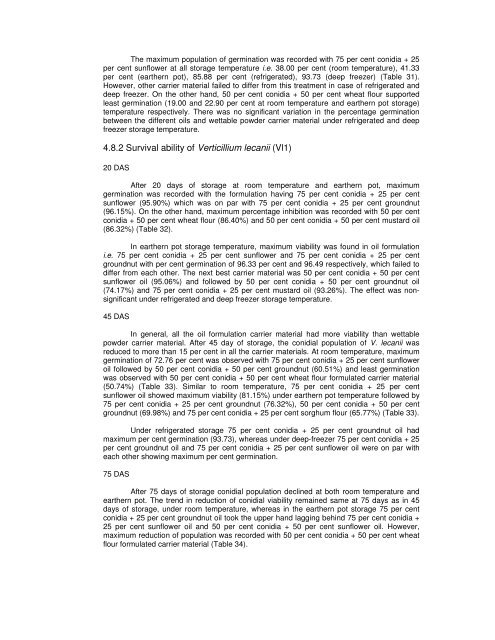ISOLATION AND CHARACTERIZATION OF ENTOMOPATHOGENIC ...
ISOLATION AND CHARACTERIZATION OF ENTOMOPATHOGENIC ...
ISOLATION AND CHARACTERIZATION OF ENTOMOPATHOGENIC ...
Create successful ePaper yourself
Turn your PDF publications into a flip-book with our unique Google optimized e-Paper software.
The maximum population of germination was recorded with 75 per cent conidia + 25<br />
per cent sunflower at all storage temperature i.e. 38.00 per cent (room temperature), 41.33<br />
per cent (earthern pot), 85.88 per cent (refrigerated), 93.73 (deep freezer) (Table 31).<br />
However, other carrier material failed to differ from this treatment in case of refrigerated and<br />
deep freezer. On the other hand, 50 per cent conidia + 50 per cent wheat flour supported<br />
least germination (19.00 and 22.90 per cent at room temperature and earthern pot storage)<br />
temperature respectively. There was no significant variation in the percentage germination<br />
between the different oils and wettable powder carrier material under refrigerated and deep<br />
freezer storage temperature.<br />
4.8.2 Survival ability of Verticillium lecanii (Vl1)<br />
20 DAS<br />
After 20 days of storage at room temperature and earthern pot, maximum<br />
germination was recorded with the formulation having 75 per cent conidia + 25 per cent<br />
sunflower (95.90%) which was on par with 75 per cent conidia + 25 per cent groundnut<br />
(96.15%). On the other hand, maximum percentage inhibition was recorded with 50 per cent<br />
conidia + 50 per cent wheat flour (86.40%) and 50 per cent conidia + 50 per cent mustard oil<br />
(86.32%) (Table 32).<br />
In earthern pot storage temperature, maximum viability was found in oil formulation<br />
i.e. 75 per cent conidia + 25 per cent sunflower and 75 per cent conidia + 25 per cent<br />
groundnut with per cent germination of 96.33 per cent and 96.49 respectively, which failed to<br />
differ from each other. The next best carrier material was 50 per cent conidia + 50 per cent<br />
sunflower oil (95.06%) and followed by 50 per cent conidia + 50 per cent groundnut oil<br />
(74.17%) and 75 per cent conidia + 25 per cent mustard oil (93.26%). The effect was nonsignificant<br />
under refrigerated and deep freezer storage temperature.<br />
45 DAS<br />
In general, all the oil formulation carrier material had more viability than wettable<br />
powder carrier material. After 45 day of storage, the conidial population of V. lecanii was<br />
reduced to more than 15 per cent in all the carrier materials. At room temperature, maximum<br />
germination of 72.76 per cent was observed with 75 per cent conidia + 25 per cent sunflower<br />
oil followed by 50 per cent conidia + 50 per cent groundnut (60.51%) and least germination<br />
was observed with 50 per cent conidia + 50 per cent wheat flour formulated carrier material<br />
(50.74%) (Table 33). Similar to room temperature, 75 per cent conidia + 25 per cent<br />
sunflower oil showed maximum viability (81.15%) under earthern pot temperature followed by<br />
75 per cent conidia + 25 per cent groundnut (76.32%), 50 per cent conidia + 50 per cent<br />
groundnut (69.98%) and 75 per cent conidia + 25 per cent sorghum flour (65.77%) (Table 33).<br />
Under refrigerated storage 75 per cent conidia + 25 per cent groundnut oil had<br />
maximum per cent germination (93.73), whereas under deep-freezer 75 per cent conidia + 25<br />
per cent groundnut oil and 75 per cent conidia + 25 per cent sunflower oil were on par with<br />
each other showing maximum per cent germination.<br />
75 DAS<br />
After 75 days of storage conidial population declined at both room temperature and<br />
earthern pot. The trend in reduction of conidial viability remained same at 75 days as in 45<br />
days of storage, under room temperature, whereas in the earthern pot storage 75 per cent<br />
conidia + 25 per cent groundnut oil took the upper hand lagging behind 75 per cent conidia +<br />
25 per cent sunflower oil and 50 per cent conidia + 50 per cent sunflower oil. However,<br />
maximum reduction of population was recorded with 50 per cent conidia + 50 per cent wheat<br />
flour formulated carrier material (Table 34).
















